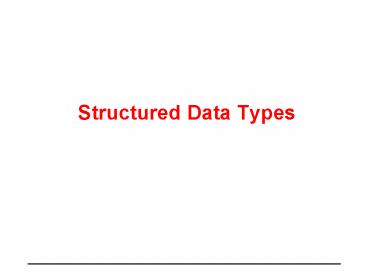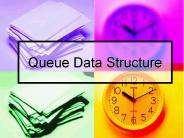Structured Data Types - PowerPoint PPT Presentation
1 / 23
Title:
Structured Data Types
Description:
Relation over individual characters based upon the collating sequence order. eg. ... values are simple and non composite. scalar data types ... – PowerPoint PPT presentation
Number of Views:20
Avg rating:3.0/5.0
Title: Structured Data Types
1
Structured Data Types
2
Date Types
- We have seen various data types
- Integer, Real, Character, Logical
- All these types define data values of different
kinds - 128, 4500, 1, 0 (Integer)
- 0.5E19, 28.0, 0.214141E2 (Real)
- hari,maithoo,cs101, fortran (character strings)
- .True., .False. (logical)
- The Data types define, besides values,
- operations, relations and intrinsic functions
- A summary given here - refer to books/manuals for
details
3
Numerical Data Types
- Constants 127, - 456, 12.76, 56.7 E 10, -
0.12E-23 - Note decimal points in mantissa but not in
exponent - no commas allowed 12,23,600
- Operations ,,/,-
- Relations gt,lt,gt,lt,,/
- Intrinsic Functions
- Real, Nint,Int, Abs, Mod, Exp,Log, Sign, Sin,
Cos, Sinh,Cosh,
4
Character Data Types
- Constants ABabDf, Fortran, CS101
- Note capital and small letters distinguished
- Operations //, (nm)
- Relations equality operators, , /
- Other comparison operators lt , lt, gt, gt
- ASCII encoding 8 bit encoding of characters
- A is 65, B is 66, etc
- a is 97, b is 98 etc
5
Lexicographic Ordering
- Collating Sequence order in which characters
occur in - ASCII set
- Relation over individual characters based upon
the collating sequence order - eg. A lt E, Z lt a, d lt s
- How to compare strings?
- Dictionary ordering (Lexicographic ordering)
- eg. AAA lt AAB, AAA lt AAAA,
- AAAA lt AB
- Intrinsic Functions Trim, Len,
6
Logical Data Types
- Constants .true., .false.
- Operations .not., .and.,.or.,.equiv,
- .nequiv.
7
Structured Data
- All these data types (except character) are
atomic - values are simple and non composite
- scalar data types
- Many real life entities are organized (or
structured) collections of simpler data values - students, accounts, employees (records with
constituent items) - pack of cards, tables, vectors, matrices
- queues, stacks, graphs
- Referring to the constituent data values rather
than the whole - results in loss of abstraction and clarity
- cumbersome
8
Structured Data Types
- Modern PL enable design of rich set of structured
data types to represent structured data - They provide constructs using which complex and
structured data types can be built from scalar
types - A PL provides
- fixed primitive types for representation of
simple data value - constructs for building organized collection from
primitive types - hence called user defined data types
9
Single Dimensional Arrays
- Array is one of the simplest and most often used
structure - Examples Vectors, list of students ordered by
roll - numbers, array of cars
in a parking lot - Array data type is provided to represent such
data - Typical array values are
- (32, 45, 67, 100, 780) - integer array
- (4.50, 345.0E10, 28.25E-12) - real array
- (Fortran, Pascal, C, C, ADA) - character array
- (.true., .false., .true., .false., .false.,
.true., .true.) - logical array
10
Properties of Arrays
- All entries in an array are values of identical
types - The data values are of some type, called the base
type - An array can contain one or more number of
entries - Every entry is associated with an index
- By default, the index of the first entry is 1,
that of second 2, etc - The number of entries is called the size or
length of the array - Any entry can be accessed directly by indicating
its index hence called random access data
structure - Arrays are called single dimensional
11
Example
- Let MARKS be an array (32,24,49,20,0)
- base type of MARKS is integer
- size or length of the array is 5
- MARKS(5) is 0 while MARKS(2) is 24
- Let Planets (Venus, Earth, Mars, Saturn,
Uranus, Neptune, Pluto) - base type is character
- length is 7
- Planets(4) is Saturn
12
Array Declarations
- Program Variables can store array values like any
other basic values - Typical declarations
- Integer, Dimension(5) Marks
- Character(len8), Dimension(7) Planets
- base type and length mentioned in declarations
- The index of these arrays, also called as
subscripts, start from 1 and end in the number
specified - The subscripts can start anywhere and end
anywhere they should be specified then - Integer, Dimension(-810) Students
- specifies the subscripts of Students to range
from -8 to 10
13
Array References
- Arrays can be referred in statements either as a
whole or individually - Individual array elements are like any other
variable of the base type - They can appear anywhere where the variables can
appear, eg. - Students(2) 5
- Marks(5) Students(2) 10
- Students(i) Student(i1)
- Passed(j) .TRUE.
- Planets(k) Jupiter
- if (Students(i) gt 0) then
- Type matching same as variables of the base type
14
Whole array references
- The whole array variable can also appear on both
rhs and lhs, eg. - Planets (/ Mars,Earth,Pluto,Neptune,Venus,Jupite
r /) - Marks Students
- These are whole array assignments the types of
both lhs and rhs should match - Types of two array valued expressions match
provided - they evaluate to arrays
- of the same size and base type
- subscript ranges may be different
- The same constant value can be assigned to all
elements of an array - Passed .FALSE.
- All the array entries are assigned the value
false useful for initialization
15
Array Initialization
- Arrays can be initialized at declarations, eg.
- integer, dimension(10) a (/
0,1,2,3,4,5,6,7,8,9 /) - initializes array a to (0,1,2,3,4,5,6,7,8,9)
- Implied do loop (Shorthand notation for loops)
can be used for initialization, eg. - a (/ (2i, i1,10) /) ! i must be declared
before use - a (/ (i,i, i 1,10,2) /)
- a is 1,1,3,3,5,5,7,7,9,9
16
Reading/Writing of Arrays
- Arrays may be read or printed as a whole, eg.
- read , a
- print , a
- Values input/output on a single line
- Implied do loops may also be used, eg.
- read , (a(i), i 1,n)
- values of a(1) to a(n), read on one line
17
Array Sections
- Arrays can be referred as a whole, per entry or
even in parts - Parts of the arrays can be referred using
sections, eg - Given an array Ex declared as follows
- integer dimension(100), Ex
- Ex(8892) - part of the array
- Ex(8),Ex(10),...,Ex(88)
- Ex(1050) - references Ex(10),Ex(11),...,Ex(50)
- Ex(285) - refer to Ex(28),Ex(33),...,Ex(98)
- Ex(282) - null array
- Ex(1100) - whole section, referred directly as
Ex itself
18
Array Bounds
- Every array has bounds - lower and upper bounds
- The above array Ex has 1 as lower bound and 100
as upper bound - Ex(i) is defined provided 1 lt i lt 100
- Any reference to Ex(-25) or Ex(111) is illegal
and may produce unknown results - A reference is illegal or not can be detected,in
general, at run-time only - Ex(j) exceeds bound or not depends on value of j
- not known at compile time - Fortran compiler provides the option of detecting
(at run-time) of array index exceeding bounds - If this option is on, it inserts code, which can
produce run-time errors - If off, you have the responsibility for illegal
references
19
Operations on Arrays
- Array assignments involve expressions involving
whole arrays - Operations are defined over arrays depending upon
the base type - Operations are lifted' from the base type
- arithmetic operations over real and integer
arrays - logical operations over logical arrays
- Operations apply point wise' to the array
entries - Arrays involved should be of the same size
20
Example
- integer, dimension(50) A, B
- integer, dimension(51100) C
- read , A, B ! reads 100 values (A
followed by B) - C 2A B 5 ! C(i) 2A(i)
B(50i) 5 - operation is applied to corresponding elements
in parallel - similar to component wise vector addition
- other arithmetic operations (except ) applied
similarly - scalar operation performed on each element
21
Relational Operators
- whole array or array sections can be compared
using relational operator - As usual, type and size constraints need to
respected - Comparison to scalars also possible
- Example
- integer, dimension(50) a, b
- logical, dimension(50) c
- c (a lt b) .and. ( a gt a(1))
- ! c(i) is .true. iff a(i) lt b(i) and
a(i) gt a(1), 1lti lt50 - similarly for other relational operators
22
Intrinsic Functions
- Many intrinsic functions available for arrays
- Lifting' of Intrinsic functions of base type to
arrays - functions of integers and reals can be applied to
integer or real arrays - functions applied pointwise - to all elements
separately - size(a) number of elements in array a
- maxval(a) and minval(a)
- maximum and minimum value in integer or real
array a
23
Intrinsic Functions (contd.)
- sum(a), product(a)
- sum or product of elements of integer or real
array a - dot_product(a,b)
- dot product of two vectors of same size
- Array operations and intrinsic functions makes
program more readable - More efficient also, as operations can be done in
parallel































